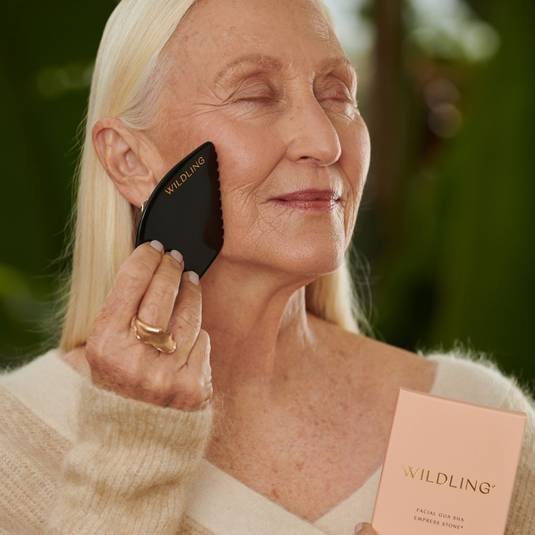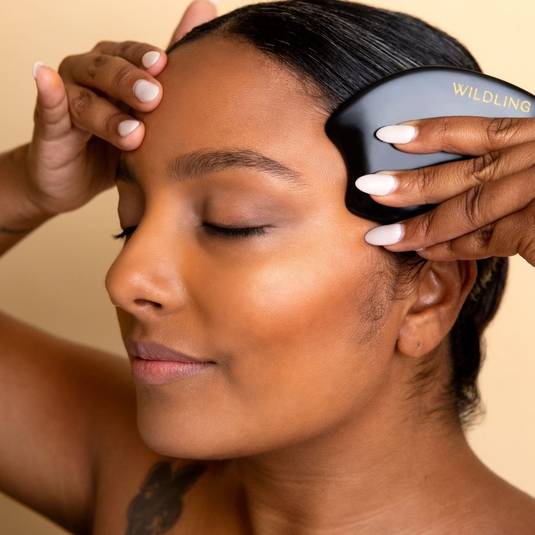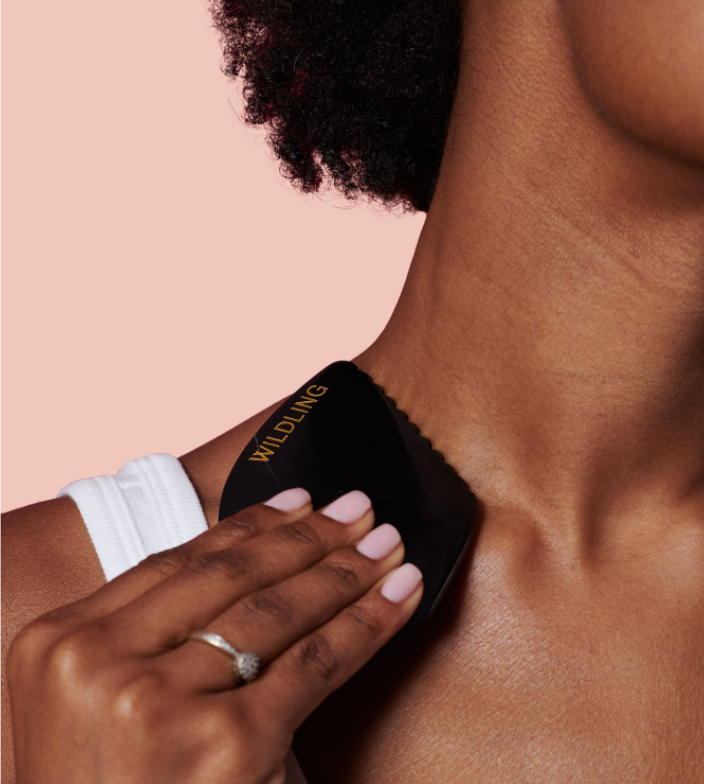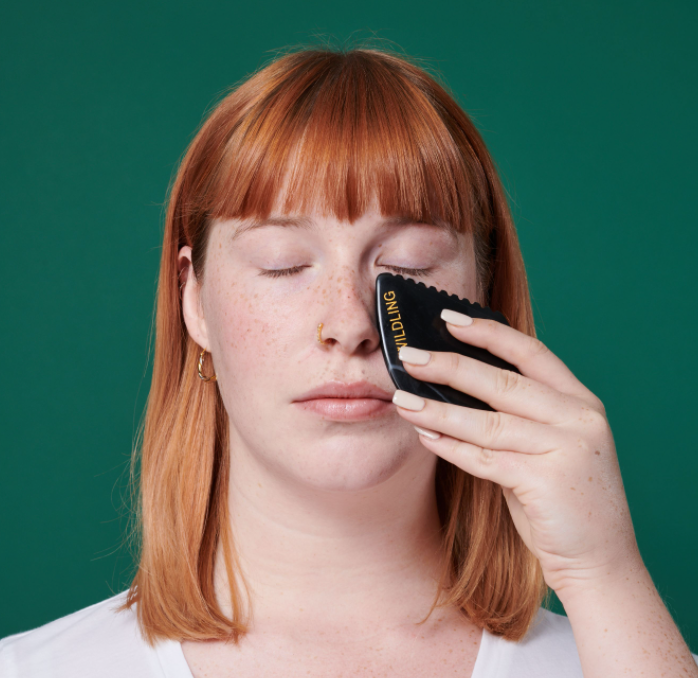There’s a reason facial gua sha seems to be popping up everywhere—because it delivers real results to the skin! Not to mention it feels so. dang. good.
Gua sha is effective because it works with the body’s lymphatic system. The lymphatic system is not well understood by western medicine (yet), but holistic practitioners have been championing it as the connection between dis-ease and healing for thousands of years. It’s thought that the ancient, Traditional Chinese Medicine practice of acupuncture, healing massage, and gua sha bodywork utilize the lymph to facilitate inner healing. To better understand all things lymph as it relates to our skin, we caught up with Britta Plug, one of our founders and the creator of New York City’s gua sha mecca Studio Britta. She’s been working with the lymph through skin massage and gua sha for over a decade and brings hundreds of client journeys and thousands of gua sha facials’ worth of experience to the conversation.
Q. So, what is lymph exactly?
A. That’s such a hard question to answer, because it’s so many things! First and foremost, it’s part of the immune system. The lymph contains white blood cells that help protect against foreign invaders. In one of Dr. Vodder’s course manuals, he says that a third of all lymph in the body is concentrated in the face, head, and neck. Different sources cite different numbers, but we have about 800 lymph nodes in the body, and of those 300 are in the neck alone!
That’s because there are many ways pathogens can enter the body through the head—our ears, eyes, nose, and mouth are vulnerable to invasion. So just by working the head, face, and neck with gua sha, we can stimulate a very high percentage of the body’s lymphatic fluid. You’re working with superficial lymph, which helps remove metabolic waste from the skin.
When you access the parasympathetic nervous system (also known as rest and digest) during a self-administered gua sha session or a facial treatment, the lymphatic system can actually detoxify and do the maintenance work it needs to do. When we’re in our sympathetic nervous system (also known as fight or flight) our body can’t do any of that repair work and deeper lymph detoxification. This is why the ritual and self-care component of gua sha are so important.
Q. Fascinating. Where are the other lymph centers in the body?
A. Aside from the head and neck, lymph’s concentrated in the armpits, the groin, behind the knees—wherever the body bends. The solar plexus region underneath the ribcage and the terminus right above the collar bones are also important lymph centers. On our faces, the edges of the face, in front of and behind the ears, and on the front and side of the neck are where the lymph nodes and lymph vessels are concentrated. I emphasize those areas whenever I’m working with a client. Interestingly, the way I originally learned gua sha didn’t emphasize those areas at all, so I’ve developed a custom method that, over time and thousands of clients, has shown better results.
I really love geeking out about lymph, particularly when it comes to its connection to our fascia. Fascia is connective tissue in the body made mostly of collagen that surrounds organs and muscles, and keeps them connected. The lymph hydrates fascia, so if there is stagnation in the lymphatic system, your inner tissues aren’t getting what they need. When we move the lymph, everything becomes pliable, more springy, and in the skin that translates as a reduction in fine lines and wrinkles because the tissues are getting plumped from the inside out.
Q. If you’re doing gua sha at home, how do you know your lymph is moving?
A. You’ll look less puffy directly afterward, and over time. During or after the session, some people describe a sensation of “flow” along the main pathway from your earlobe to the dip above your collarbone. For me, it feels like a slight ache when the lymphatic system is activated. It should be a subtle sensation. With gua sha, and when you’re doing any work with the lymph, pressure should be very, very light because the lymph is superficial, it’s right underneath the skin and doesn’t need much to move. In fact, with too much pressure you’ll bypass it.
Q. What are some signs of “stagnant” lymph?
A. Swelling is one of the big ones. Of course, it’s different from an injury like an ankle sprain. That’ll swell with lymph and that’s the body’s immune response to pain—it’s supposed to happen. But chronic swelling not related to an acute injury, like swollen ankles and feet, swollen eyelids, puffiness around the jaw is a good indicator that your lymph isn’t moving how it should.
Congestion in the face in the form of blackheads and hyperpigmentation are also signs of stagnant lymph. Even without these, clients often come in with concerns about dull skin and a tired-looking face that can be improved by stimulating the lymph.
Q. What are some signs of healthy, mobile lymph?
A. When lymph starts to move again, especially in the face, a rosy glow will return. Over time, using facial gua sha can clear breakouts, blackheads, acne, and hyperpigmentation. Someone with good lymph flow has skin that looks like there’s clarity, rosy cheeks, and yes maybe a few real lines and wrinkles, but the skin is not dull or murky. There’s a brightness, a glow, and a natural sculpted-ness that comes with consistent gua sha practice.
Q. Does lymph keep the skin healthy?
A. It plays a major role in the skin’s detoxification by helping to remove cellular and metabolic waste from the system. Lymph flushes out toxins and buildup from our body’s regular processes that can contribute to breakouts. When lymphatic flow is healthy, skin looks fresh, hydrated, and plump.
Q. Gua sha is great, but what are other ways to move lymph?
A. Any kind of physical movement is good for the lymph. It doesn’t have a pump like the circulatory system. Our heart is the pump of our circulatory system, and arteries and veins are made of muscles which help keep our blood moving even when we’re not, but the lymphatic system doesn’t have that kind of autonomy, which is why, for example, when you wake up you may look a little puffy and it decreases with time. As you move around, lymph does as well, slowly draining from your face, hands and feet.
Epsom salt baths, staying hydrated, drinking lemon water, dry body brushing, gentle massage, and jumping on a trampoline are all good ways to support your lymphatic system, too.
Q. Skeptics say that our bodies were designed to detox and help the lymph on their own. What would you say to that?
A. Sure, but our bodies were not designed to handle the toxic load of modern life! If we were all living like we were a thousand years ago, we may not need gua sha and lymph drainage as much as we do now. We were made to be moving around all day, eating fresh foods from the earth, experiencing a drastically reduced toxic load. As a culture, our time spent moving daily continues to decrease, our plastic consumption keeps going up, pollution is increasing in air and water. It’s harder to find out exactly what’s in our food… so yes! I believe that our bodies can use the extra help.








